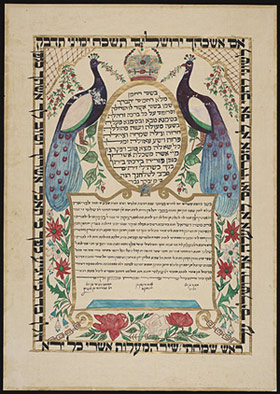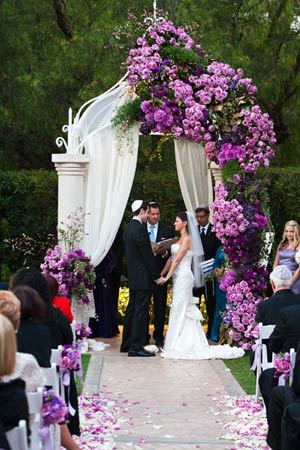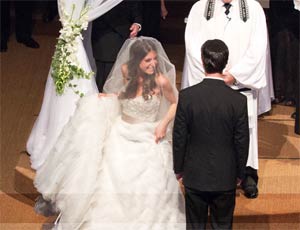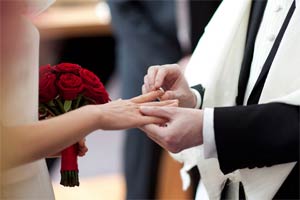Ceremony
Signing of the Ketubah

In Orthodox communities, after the tish the ketubah (Jewish marriage contract) is signed by the groom, the rabbi, and two male witnesses. In Reform and Conservative congregations, the bride may also sign the Ketubah, and additional lines can be added for female witnesses, too. – via TheKnot
The Ketubah, or marriage contract, is one of the oldest Jewish wedding traditions, dating back two thousand years. Traditionally, the Ketubah is a legal document protecting the bride’s rights, and thus is the possession of the bride. In the progressive spirit, many couples today choose to have a Ketubah that is egalitarian and contemporary, expressing the bride and groom’s commitment to care for one another and to create a Jewish home together. Typically, it is read and signed by witnesses, the rabbi, and the bride and groom in front of close family and friends immediately preceding the wedding ceremony.
Filed in: Ceremony
Chuppah

Jewish Wedding: Chuppah
The ceremony takes place under a Chuppah, or wedding canopy. It represents God’s sheltering presence in the lives of the bride and groom, as well as the new home that they will build together. The presence of family under the Chuppah, as well as its lack of walls, signify that their home will always be open to family and friends.
Filed in: Ceremony
Bedeken (Veiling of the Bride)
 Legend has it that this tradition, which means “checking,” dates back to Biblical times, when Jacob was tricked by his father-in-law Laban. Jacob was presented with an already-veiled bride; he discovered only after the ceremony that she was not his intended bride, Rachel, but instead her sister, Leah. Often we will include Veiling of the Bride either immediately following the Ketubah signing, or as part of the processional to the Chuppah. By checking under the veil, the groom indicates that he is sanctifying the bride to be his wife.
Legend has it that this tradition, which means “checking,” dates back to Biblical times, when Jacob was tricked by his father-in-law Laban. Jacob was presented with an already-veiled bride; he discovered only after the ceremony that she was not his intended bride, Rachel, but instead her sister, Leah. Often we will include Veiling of the Bride either immediately following the Ketubah signing, or as part of the processional to the Chuppah. By checking under the veil, the groom indicates that he is sanctifying the bride to be his wife.
Filed in: Ceremony
Circling

Jewish Wedding, The Ceremony – Circling
Before the Bride and groom enter the Chuppah, traditionally the bride circles the groom seven times. Representing our egalitarian views of marriage, often modern couples choose to adapt this ritual by both bride and groom circling the other three times with the final circle done together hand in hand. Each circle represents one of the moral obligations with which we bind ourselves in marriage: “I will betroth you to me forever. I will betroth you to me with fairness, justice, love and compassion. I will betroth you to me with faith and you shall know God” (Hosea 2:21-22)
Filed in: Ceremony
Erusin (Betrothal)

Jewish Wedding: Erusin
According to Jewish law, the giving and accepting of an item of value in the presence of witnesses is what sanctifies a marriage. Therefore, in modern times, the bride and groom exchange rings as they declare to one another, in Hebrew and in English, “Behold, you are consecrated to me with this ring, in accordance with the laws of Moses and Israel.” Typically, the rings are solid, without any breaks or stones, signifying the wholeness and union achieved through marriage. The rings are placed on their right index fingers, due to the ancient belief that the forefinger is connected by a direct line to the heart. After which, they can be moved to the ‘ring finger’ on one’s left hand.
Filed in: Ceremony

